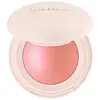What's inside
What's inside
 Key Ingredients
Key Ingredients

 Benefits
Benefits

 Concerns
Concerns

 Ingredients Side-by-side
Ingredients Side-by-side

Synthetic Fluorphlogopite
Isododecane
EmollientBoron Nitride
AbsorbentDimethicone
EmollientHydrogenated Polyisobutene
EmollientMica
Cosmetic ColorantSilica
AbrasiveMagnesium Myristate
Magnesium Stearate
Cosmetic ColorantPentaerythrityl Tetraisostearate
EmollientAluminum Starch Octenylsuccinate
AbsorbentPhenoxyethanol
PreservativeTin Oxide
AbrasiveCaprylyl Glycol
EmollientDiethylhexyl Syringylidenemalonate
Skin ProtectingTriethoxycaprylylsilane
Caprylic/Capric Triglyceride
MaskingCI 15850
Cosmetic ColorantCI 77007
Cosmetic ColorantCI 77491
Cosmetic ColorantCI 77891
Cosmetic ColorantSynthetic Fluorphlogopite, Isododecane, Boron Nitride, Dimethicone, Hydrogenated Polyisobutene, Mica, Silica, Magnesium Myristate, Magnesium Stearate, Pentaerythrityl Tetraisostearate, Aluminum Starch Octenylsuccinate, Phenoxyethanol, Tin Oxide, Caprylyl Glycol, Diethylhexyl Syringylidenemalonate, Triethoxycaprylylsilane, Caprylic/Capric Triglyceride, CI 15850, CI 77007, CI 77491, CI 77891
Synthetic Fluorphlogopite
Dimethicone
EmollientDimethicone/Vinyl Dimethicone Crosspolymer
Skin ConditioningOctyldodecyl Stearoyl Stearate
EmollientTapioca Starch
Boron Nitride
AbsorbentOctyldodecanol
EmollientDiisostearyl Malate
EmollientSilica
Abrasive1,2-Hexanediol
Skin ConditioningCaprylyl Glycol
EmollientTin Oxide
AbrasivePolymethylsilsesquioxane
CI 77891
Cosmetic ColorantCI 77491
Cosmetic ColorantCI 15850
Cosmetic ColorantCI 19140
Cosmetic ColorantSynthetic Fluorphlogopite, Dimethicone, Dimethicone/Vinyl Dimethicone Crosspolymer, Octyldodecyl Stearoyl Stearate, Tapioca Starch, Boron Nitride, Octyldodecanol, Diisostearyl Malate, Silica, 1,2-Hexanediol, Caprylyl Glycol, Tin Oxide, Polymethylsilsesquioxane, CI 77891, CI 77491, CI 15850, CI 19140
Ingredients Explained
These ingredients are found in both products.
Ingredients higher up in an ingredient list are typically present in a larger amount.
Boron Nitride is compound consisting of boron and nitrogen. It is used to absorb oil and modify adherence/ slip in products.
This means it is often used in makeup products to help them last longer.
Caprylyl Glycol is a humectant and emollient, meaning it attracts and preserves moisture.
It is a common ingredient in many products, especially those designed to hydrate skin. The primary benefits are retaining moisture, skin softening, and promoting a healthy skin barrier.
Though Caprylyl Glycol is an alcohol derived from fatty acids, it is not the kind that can dry out skin.
This ingredient is also used as a preservative to extend the life of products. It has slight antimicrobial properties.
Learn more about Caprylyl GlycolCi 15850 is the pigment color red. It is an azo dye and created synthetically.
Azo dyes need to be thoroughly purified before use. This allows them to be more stable and longer-lasting.
This ingredient is common in foundations, lipsticks, and blushes. This color is described as brown/orangey red.
It has many secondary names such as Red 6 and Red 7. According to a manufacturer, Red 6 usually contains aluminum.
Learn more about CI 15850Ci 77491 is also hydrated iron III oxide. It's sole purpose is to give a red/pink hue to products.
Iron III oxides are classified as inorganic chemicals for coloring.
Synthetically created Ci 77491 is considered safer than those naturally found. This is because the synthetically created version may contain less impurities. Iron oxides are generally non-toxic and non-allergenic.
Learn more about CI 77491Ci 77891 is a white pigment from Titanium dioxide. It is naturally found in minerals such as rutile and ilmenite.
It's main function is to add a white color to cosmetics. It can also be mixed with other colors to create different shades.
Ci 77891 is commonly found in sunscreens due to its ability to block UV rays.
Learn more about CI 77891Dimethicone is a type of synthetic silicone created from natural materials such as quartz.
What it does:
Dimethicone comes in different viscosities:
Depending on the viscosity, dimethicone has different properties.
Ingredients lists don't always show which type is used, so we recommend reaching out to the brand if you have questions about the viscosity.
This ingredient is unlikely to cause irritation because it does not get absorbed into skin. However, people with silicone allergies should be careful about using this ingredient.
Note: Dimethicone may contribute to pilling. This is because it is not oil or water soluble, so pilling may occur when layered with products. When mixed with heavy oils in a formula, the outcome is also quite greasy.
Learn more about DimethiconeSilica, also known as silicon dioxide, is a naturally occurring mineral. It is used as a fine, spherical, and porous powder in cosmetics.
Though it has exfoliant properties, the function of silica varies depending on the product.
The unique structure of silica enhances the spreadability and adds smoothness, making it a great texture enhancer.
It is also used as an active carrier, emulsifier, and mattifier due to its ability to absorb excess oil.
In some products, tiny microneedles called spicules are made from silica or hydrolyzed sponge. When you rub them in, they lightly polish away dead skin layers and enhance the penetration of active ingredients.
Learn more about SilicaSynthetic Fluorphlogopite is the synthethic version of mica. It consists of fluorine, aluminum and silicate.
Synthetic Fluorphlogopite is used to add volume to products.
It is considered non-irritating on the skin.
Learn more about Synthetic FluorphlogopiteTin Oxide is an inorganic oxide used to add opacity and volume to a product. In nature, it is already found in mineral form. The main ore of tin is an opaque and shiny mineral called casseterite.
Tin Oxide helps remove translucency in a product, or make it more opaque. Besides adding opacity, tin oxide is used for bulking to add volume.